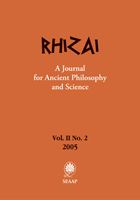Plato’s and Aristotle’s Explanation of Human Posture
Plato’s and Aristotle’s Explanation of Human Posture
Author(s): Pavel GregorićSubject(s): Philosophy
Published by: Издателство »Изток-Запад«
Keywords: physiology; cognitive abilities; non-rational animals; head; reincarnation; scala naturae; rationality; bodily proportion; dwarf
Summary/Abstract: Both Plato and Aristotle see a connection between two unique features of human beings: their erect posture and their ability to think. Moreover, both philosophers think that human beings have the erect posture precisely for the sake of thinking. However, their explanations are very different. Plato argues that erect posture is a necessary condition of unimpeded observation of the heaven, and unimpeded observation of the heaven is in turn a necessary condition of thinking. Aristotle claims that a particular bodily proportion is a necessary condition of both thinking and erect posture – a hypothetical necessity for thinking, and a simple necessity for erect posture. I compare the two explanations and suggest reasons for Aristotle’s dissent from Plato.
Journal: Rhizai. A Journal for Ancient Philosophy and Science
- Issue Year: II/2005
- Issue No: 2
- Page Range: 183-196
- Page Count: 14
- Language: English
- Content File-PDF

